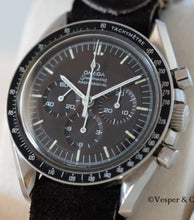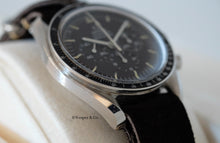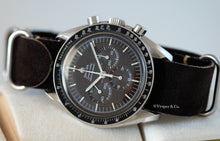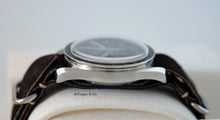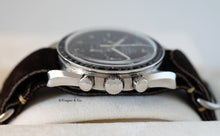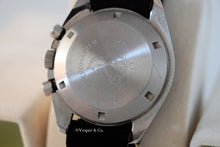
Omega. A Rare and Early Stainless Steel Chronograph Wristwatch
Model: Speedmaster Professional
Reference: 145-022-69ST
Circa: 1969
Cal. 861 mechanical movement, 17 jewels, brown dial, luminous baton numerals, three engine turned subsidiary dials for 12 hour and 30 minute registers and constant seconds, stainless steel case, black bezel with tachometer scale calibrated to 500 units, two round chronograph buttons in the band, screw down crown, lyra lugs, screw back engraved with Speedmaster logo, stainless steel link bracelet with deployant clasp, case, dial, and movement signed
39.5mm.
More about Omega:
One of the most well-known chronograph models, the Omega Speedmaster was developed by Pierre Moinat (head of Omega’s design), Claude Baillod (case designer) and George Hatmann (prototype developer) in the mid-1950’s. The Speedmaster model was launched in 1957 as a sport and racing chronograph, and at the time was associated with the Olympic Games, with Omega being the official timekeeper. Over the next year, demand for the Speedmaster would skyrocket, appealing to everyone from athletes to car racers to scientists.
The very first Speedmaster model was the reference 2915, known as the “Broad Arrow” for its very distinctive luminous arrow-shaped hour hand. Inside, it featured the legendary caliber 321, which was used for the early years of Speedmaster production. Over the next eleven years, the Speedmaster design would evolve to have Alpha hands and finally baton hands, steel bezels would be replaced with black bezels, and even case shape would change slightly to allow for protection to the crown and chronograph pushers and be more water-resistant.
In 1968, Omega began using the caliber 861, which was more accurate, as well as costing less to produce. Designed by Albert Piguet of Lemania, the same designer of the Caliber 321, the caliber 861 changed the column wheel switching mechanism, used a flat balance-spring, and increased the vibrations per hour from 18,000 to 21,600. Speedmasters with this caliber were given a new reference number, 145.022. This reference was available with a few different case back engravings – the earliest with the Seahorse engraving (used between the end of 1968 and before 1970), such as the present watch. From 1970 onward, the case back would have “The First Watch Worn on the Moon” engraved, some with the rare additional “Apollo XI 1969” engraving, and others with “Flight-Qualified by NASA For All Manned Space Missions”.
First generation reference 145.022 Speedmasters are highly sought after for their extremely short production run which lasted a little over a year. Examples such as the present watch with all-original details and a dial that has aged to an attractive dark chocolate brown are even more desirable by collectors. A first generation model is identified by a number of dial details, including a painted Omega logo on the dial, the designation “Professional” below the logo, and a spear-shaped chronograph hand. They also feature a bezel that has a tachometer scale calibrated to 500 units, with a dot over the “90” unit or a dot next to the “90” unit, and an accented “E” in “tachymetre”. This particular example not only features all of the early and original details seen only on first generation reference 145.022 Speedmasters, but it is in excellent condition, with the lugs retaining sharp definition and facets, and a charmingly aged dial that has transformed to a striking dark brown that enhances the cream-colored luminous material.






